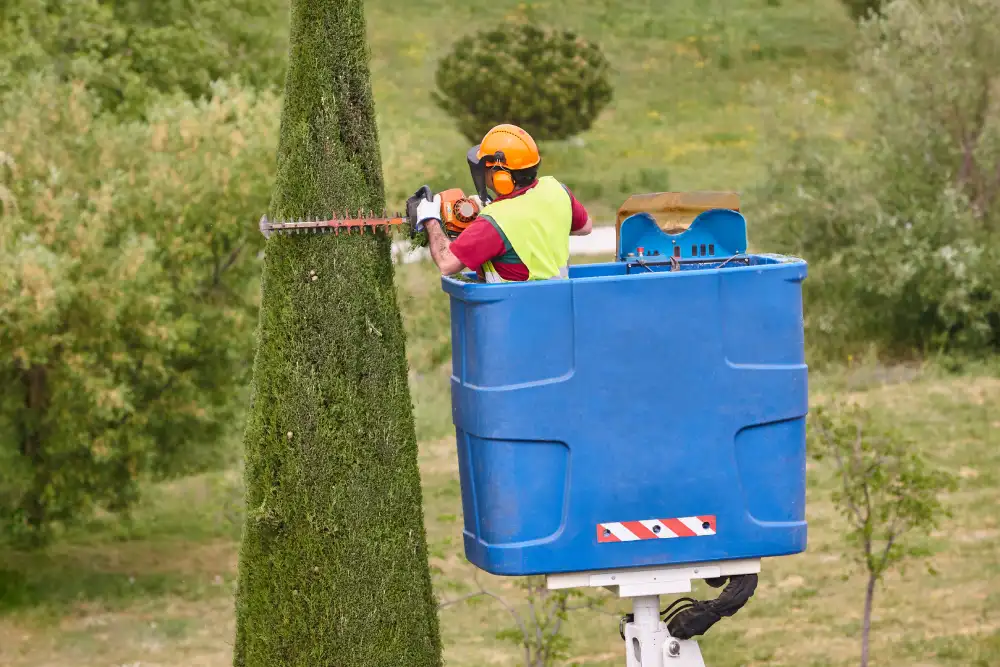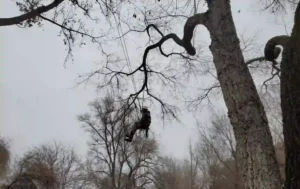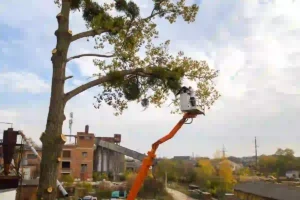The best time to trim most trees is November through February during dormant season. Oak trees need December through February only because of oak wilt disease. Maple trees get trimmed in summer – June through August – to prevent sap bleeding. Fruit trees need winter pruning before buds swell. Palm trees get trimmed during growing season from late spring through early fall.
Timing your tree trimming right saves you 20-40% on costs. TreeTrimmingCostCalculator.com factors in seasonal pricing so you get accurate estimates. Wrong timing kills trees. Or costs you extra money. Sometimes both.
Why Timing Matters More Than You Think
Trees respond to seasonal changes in ways most people don’t understand. Cut branches when the tree is pumping nutrients and water at full speed and you’re creating wounds during maximum stress.
During dormancy trees slow their metabolic processes. Wounds heal with less overall stress on the system. You can also see the tree structure clearly without leaves getting in the way.
Money factor – winter trimming costs way less. December through February demand drops and companies offer serious discounts. Summer trimming when everyone needs storm damage fixed? That’s when you pay premium rates.
Oak Trees Need Special Disease Prevention
Oak wilt disease spreads through fresh cuts. This fungal infection kills trees in months, not years.
Never trim oaks April through October. Beetles that carry oak wilt stay active during warm months and they find fresh cuts fast.
Trim oaks December through February only. Some arborists push this to early March in northern areas but you’re taking risks after February.
Young oak trees under 3 years old get different treatment. Remove only dead or broken branches regardless of season. Young oaks don’t have energy reserves to handle trimming stress.
Storm damage to oaks during growing season? You have to seal cuts immediately with pruning paint. Most arborists don’t recommend pruning paint for other trees. Oaks are different.
Pine Trees Follow Weird Rules
Pines don’t go fully dormant so winter-only rules get complicated.
Best timing: late fall through early spring. But never cut the central leader trunk. This kills pine trees by destroying their growth pattern.
Pine trimming mostly involves removing lower branches as trees mature. Called “limbing up” and it’s best done late winter before spring growth.
Common mistake with pines – people think more cutting creates better shape. Pine trees develop their form naturally. Heavy pruning creates weak branch attachments that break during storms.
Young pines need almost no trimming. Mature pines benefit from deadwood removal and selective thinning every 3-5 years.
Fruit Trees Require Annual Attention
Fruit trees need annual pruning to produce quality fruit and prevent disease. High maintenance compared to shade trees.
Best timing: late winter while dormant. January through early March depending on climate zone. Finish before buds start swelling.
Apple and pear trees get pruned more aggressively than stone fruits. Cherries and peaches are more susceptible to bacterial infections through pruning cuts.
Citrus trees in warm climates can be pruned almost year-round except during fruit development. Late winter still safest.
Goal with fruit tree pruning is creating open center for light penetration and air circulation. Prevents fungal problems that hit overgrown fruit trees.
Maple Trees Break the Winter Rule
Maples are better trimmed mid-summer than winter. They’re “bleeders” – cut them during winter or early spring and they ooze sap for weeks.
This doesn’t necessarily harm the tree but it looks bad and attracts insects.
Best timing for maples: June through August when sap flow slows. Tree handles wounds better during this period.
Sugar maples, red maples, silver maples all follow this pattern. Norwegian maples bleed less but still benefit from summer pruning.

Palm Trees Need Growing Season Trimming
Palm trees aren’t actually trees. They’re giant grass plants. Changes everything about trimming timing and technique.
Best palm tree trimming timing: late spring through early fall when palms actively grow. Unlike other trees, palms handle pruning better during active periods.
Never remove green fronds. Only brown, dead, or broken fronds get cut. Removing green fronds weakens palms and causes nutrient deficiencies.
Most palm species need trimming 1-2 times yearly. Fast-growing varieties like coconut palms might need attention 3 times annually in tropical climates.
Crepe Myrtles Need Early Spring Work
Crepe myrtles get trimmed before new leaves emerge in early spring. February in southern climates, March in northern areas where they grow.
“Crepe murder” is real problem. Those topped crepe myrtles with thick, knobby trunks everywhere? That’s wrong technique. Crepe myrtles should be selectively pruned to maintain natural vase shape.
Remove suckers from base, thin overcrowded branches, remove branches growing toward center. Light pruning every 2-3 years beats heavy cutting.
Regional Climate Changes Everything
Climate zones shift timing recommendations significantly. Georgia timing doesn’t work in Minnesota.
Northern climates zones 3-5: extend dormant season pruning through March. Spring arrives later giving more time.
Southern climates zones 8-10: start dormant season pruning earlier, sometimes October for some species. Growing seasons last longer.
Mountain regions: altitude affects timing more than latitude. Higher elevations mean later spring starts and earlier winter dormancy.
Coastal areas: mild winter temperatures confuse tree dormancy cycles. Watch for bud break rather than following calendar dates.
Seasonal Cost Differences Are Huge
TreeTrimmingCostCalculator.com factors in seasonal pricing variations because costs change dramatically by timing.
Cheapest period: December through February when demand drops. Companies offer 30-40% discounts during slow periods.
Most expensive: late spring through summer when storm damage and insect problems create urgent need.
Emergency rates: storm damage trimming costs 2-3 times normal rates when everyone needs service.
Budget-conscious approach: book winter trimming in early fall when companies schedule slower season work. Use our cost calculator to compare seasonal pricing and find optimal timing for budget and tree health.
What Goes Wrong With Bad Timing
Poor timing doesn’t just stress trees. Creates expensive problems.
Trimming during active growth stimulates excessive new growth that’s weak and breaks easily. These “water sprouts” often need removal within a year.
Cutting during pest-active periods invites infestations. Fresh cuts release chemical signals that attract boring insects and bark beetles.
Disease transmission increases when trees get cut during warm, humid periods when fungal spores stay active.
Late season pruning stimulates new growth that doesn’t harden off before winter. Leads to freeze damage.
Emergency Situations Change the Rules
Storm damage creates different timing requirements. Safety trumps optimal tree health timing.
Broken branches hanging over houses need immediate removal regardless of season or tree type. Leaving dangerous branches creates liability issues and property damage risks.
Emergency tree work costs more. Way more. Storm damage creates high demand and companies charge accordingly.
Insurance considerations matter. Some policies require immediate action on storm-damaged trees. Others want assessment before removal. Check your policy before cutting.
Tools and Techniques Vary by Season
Winter trimming allows heavier equipment on frozen ground. Reduces lawn damage from bucket trucks and chippers.
Summer trimming requires more careful equipment placement. Soft ground and active lawns limit access options.
Wound treatment changes by season. Fresh cuts during growing season benefit from immediate sealing in some cases. Winter cuts generally left to heal naturally.
Clean cuts matter more during growing season when disease transmission risk stays higher. Sharp tools and proper technique become more critical.
Professional vs DIY Timing Considerations
Small tree trimming during optimal timing can be DIY project. Large trees or wrong-season emergency work needs professionals.
Professional arborists understand species-specific timing better than general landscapers. Certified arborists worth extra cost for valuable or difficult trees.
Timing affects contractor availability. Popular arborists book winter work months in advance. Emergency services available year-round but cost significantly more.
What is Best Time to Trim Each Type of Tree – Getting the Timing Right
Most trees benefit from dormant season trimming December through February. Species-specific needs override general rules.
Consult certified arborist when uncertain. International Society of Arboriculture maintains directories of qualified professionals who understand regional timing variations.
Tree trimming timing affects tree health, your budget, and long-term landscape success. Getting it right first time prevents expensive corrections later.
Before scheduling your tree trimming project, use TreeTrimmingCostCalculator.com to estimate costs based on your specific trees, timing, and location. Helps you make informed decisions that protect both trees and budget.



